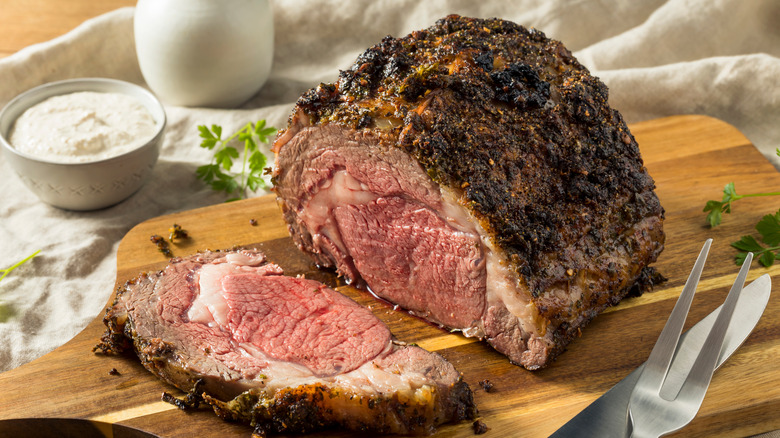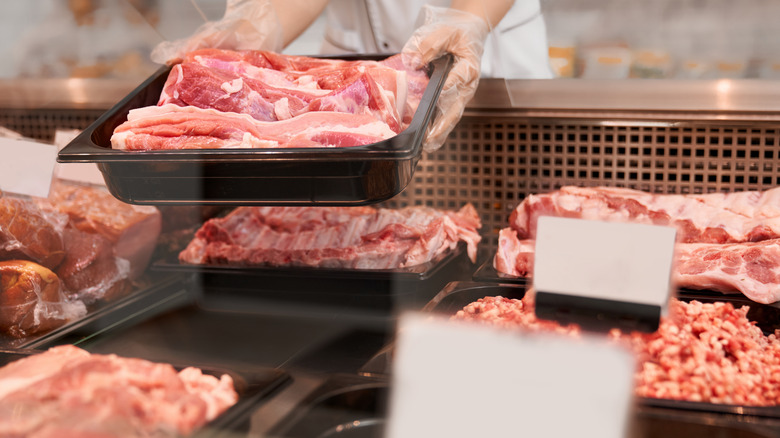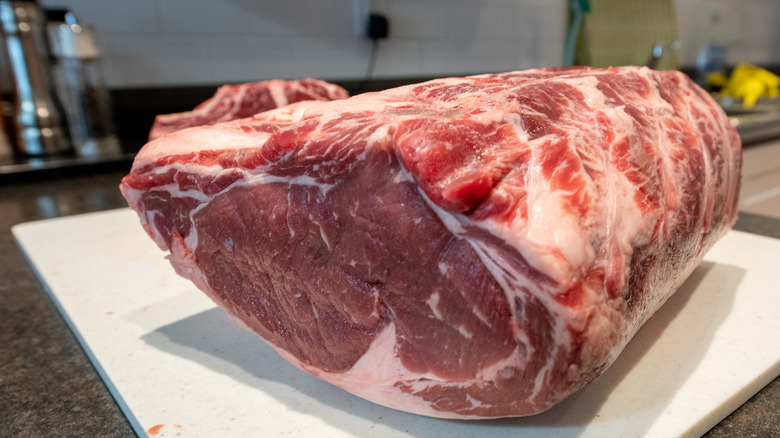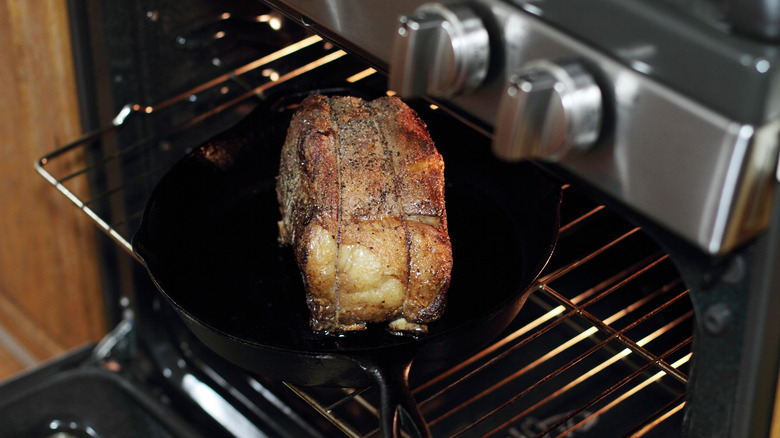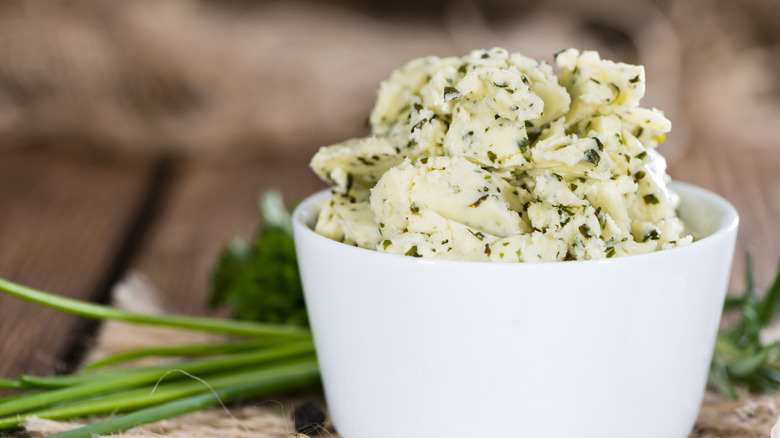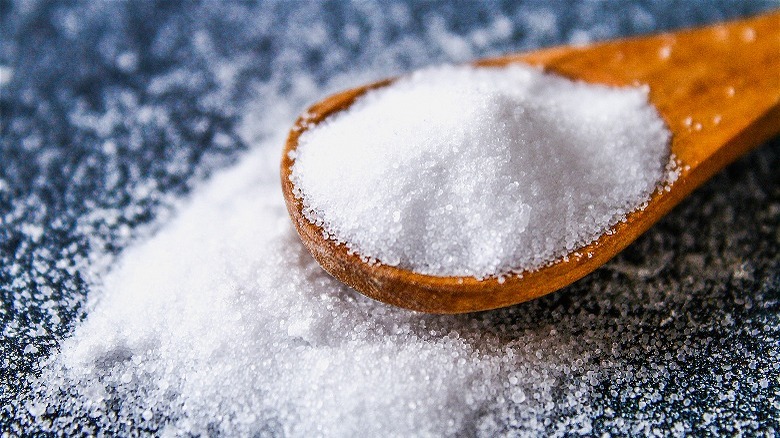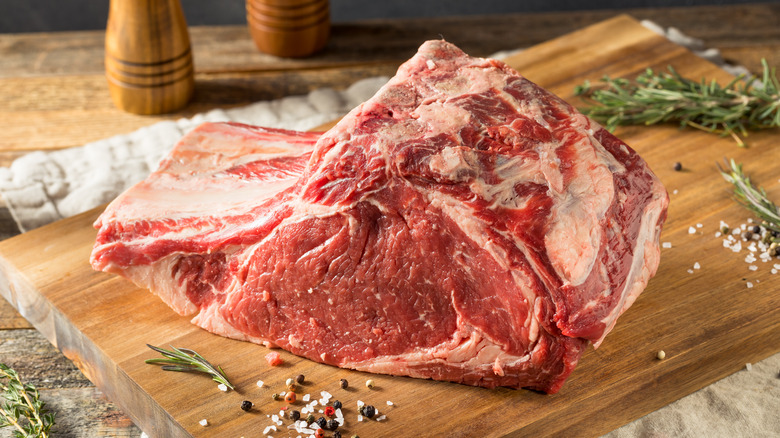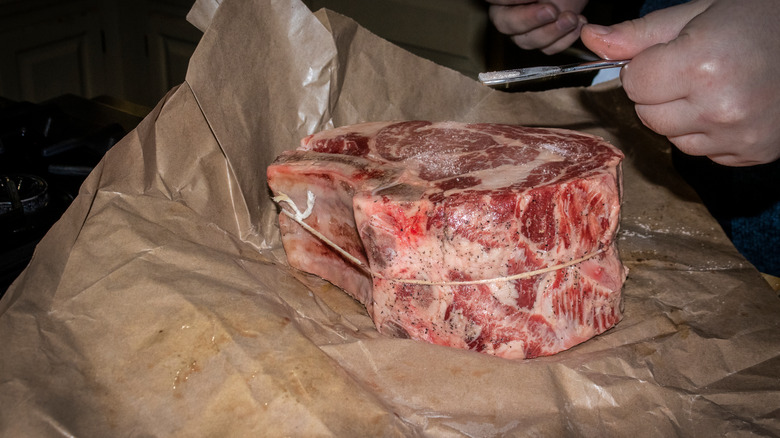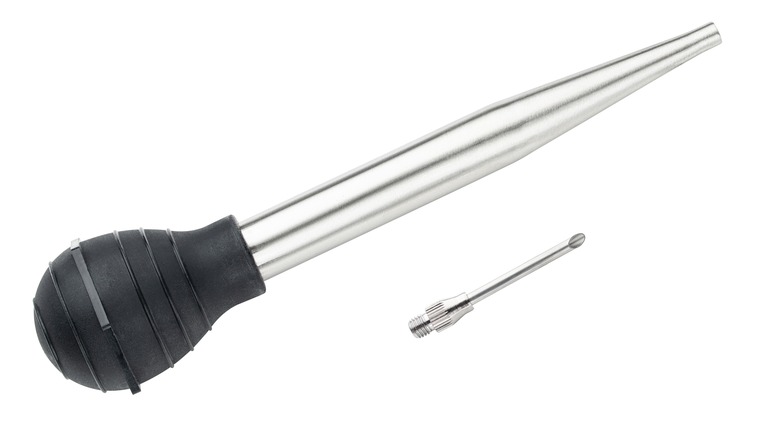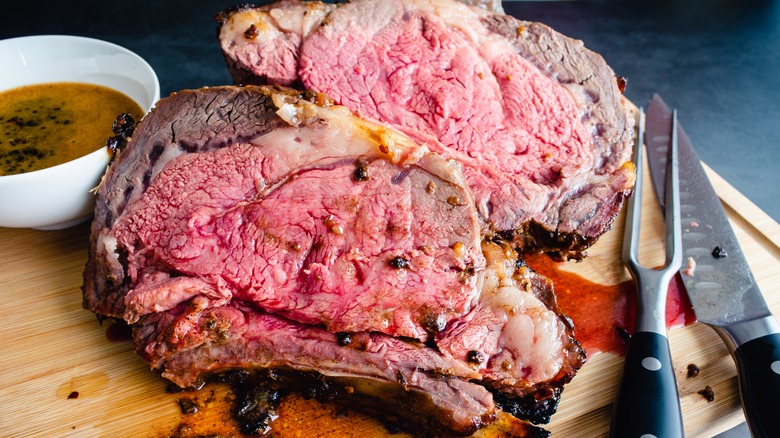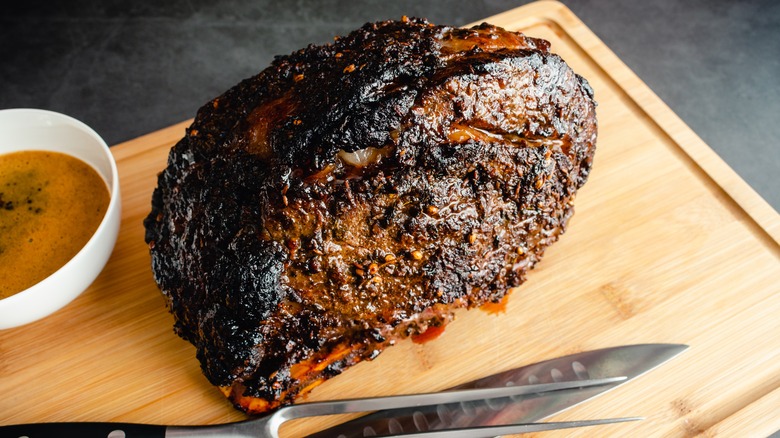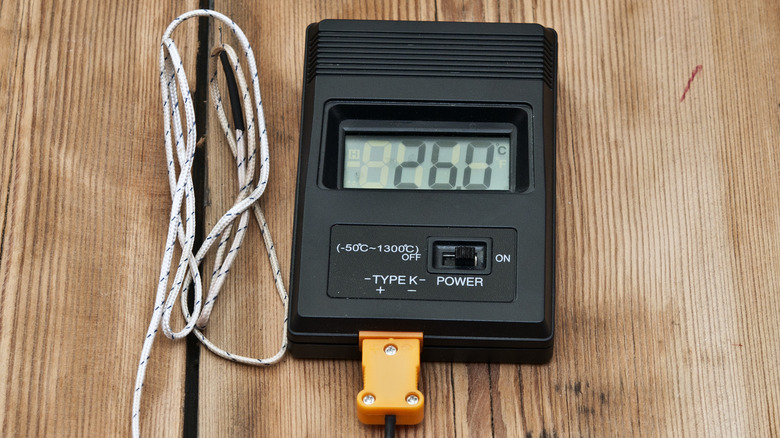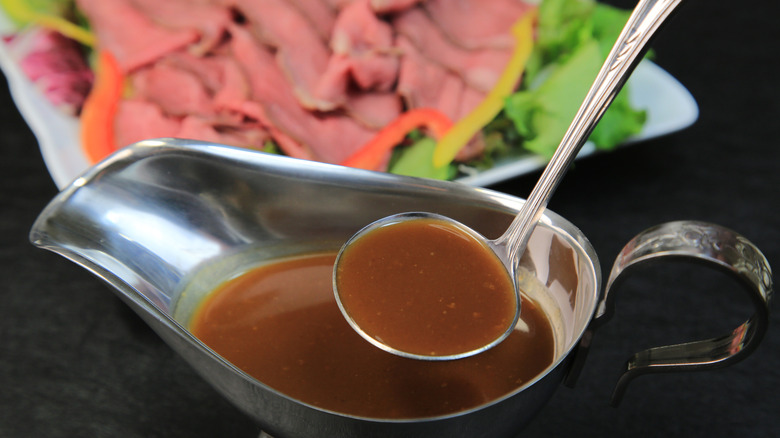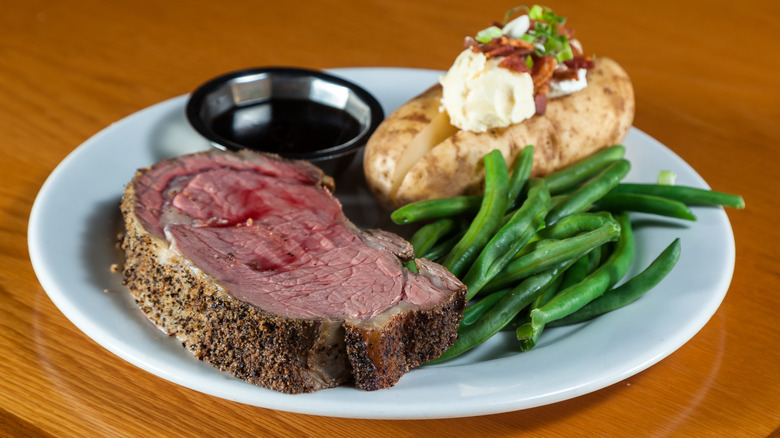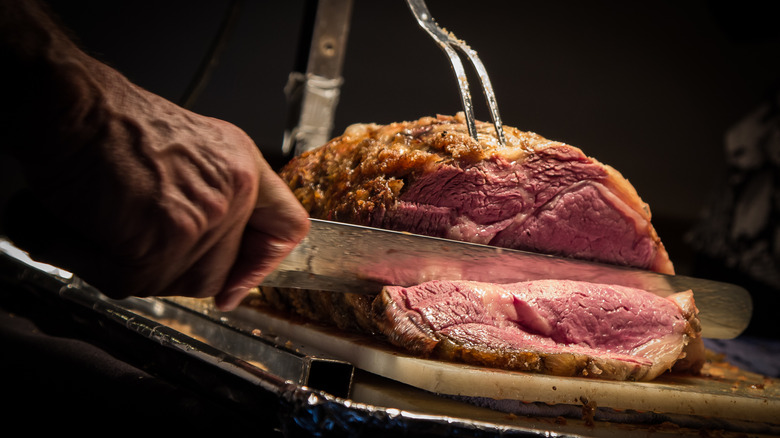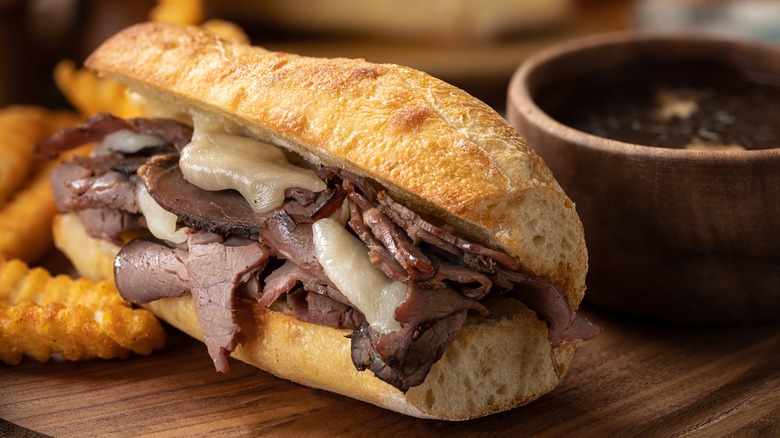15 Ways To Make Your Prime Rib Roast Taste Even Better
A prime rib roast is a real treat. It may be something you only order from nice restaurants on special occasions. But did you know that you can make your own prime rib roast at home? If you do it right, it could end up tasting better than what you'd get during a night out.
If you want to achieve this goal, it all starts with the cut of meat. A prime rib roast is a top-quality cut. When prepared properly, it will be tender and juicy, with an explosion of flavors in your mouth. It's also sometimes called a standing rib roast, because the meat is roasted in a "standing" position, with the bones holding the meat up.
If you've never heard of a prime rib roast, you're going to want to tune in. If you've already made a few prime rib roasts, you might be looking for new ways to make yours taste even better. Either way, you've come to the right place. We're going to explore several ways to ensure that the next, or first, prime rib roast you make turns out beautifully.
1. Choose the best cut of meat
The best prime rib roast starts with a high-quality piece of meat. One thing you will need to decide is whether to purchase the first cut or the second cut. The first cut consists of ribs numbered 10 through 12. These ribs are closer to the loin region, the section is sometimes referred to as the loin end. This is the best cut of prime rib, because the tender rib-eye muscle is included in it. While not quite as tender, the second cut is nice to consider. It is made of rib numbers six to nine. Because of its location farther from the loin and closer to the chuck end, there are more muscles in this cut. This gives it a less uniform look when sliced and served.
Another important consideration is deciding whether or not you want prime-grade or choice-grade beef. Prime is the top grade given by the USDA. Beef with this label is nicely marbled. It must contain at least 10% intramuscular fat. With all of this marbling, a prime rib roast will be exceptionally tender. Choice beef –which is a step down from prime-grade beef — is also marbled, but less so. It won't be as tender as a prime-grade standing rib roast, but it will also be a good deal less expensive. Choice-grade beef typically costs around 25% less than prime-grade beef.
2. Let it come to room temperature
Never take a standing rib roast from the refrigerator and put it directly into the oven. If you do so, your roast may end up unevenly cooked. The outside of the roast will be warmer than the center. When you remove the roast from the oven, only a small section will be cooked to the ideal temperature, while the outer sections of the roast will be overdone, leaving them drier and less desirable.
Some patience and preparation are necessary when making a prime rib roast. You should aim to take it out of the refrigerator a minimum of two hours before you plan on cooking it — and more like three hours if you're making a very large roast. Place the roast on a cutting board or in the roasting pan and leave it on the counter. This will allow the inside and outside of the roast to come to a more consistent temperature, allowing for more even cooking in the oven.
3. Put it in a really hot oven, then lower the temperature
When you're making a standing rib roast, you should start by preheating the oven before putting the roast in. While many roasts go into a 325-degree oven, you'll want to do things a bit differently when cooking a prime rib roast. Heat the oven up to 450 degrees. Don't worry, it won't stay here the whole cooking time and you won't burn your roast. Rather, you'll be putting the roast into the 450-degree oven for about 15 minutes.
Starting the roast in a really hot oven will give the roast a nice sear, helping to make it brown, crispy, and more enjoyable. Moreover, it also helps keep more of the juices inside the roast, allowing for a juicier finished product. After 15 minutes in a really hot oven, turn the oven down to 325 degrees and let the roast continue baking until the internal temperature matches your desired doneness.
4. Spread herb butter over the meat
If you want the juiciest and most succulent prime rib roast, then you'll want to smear the raw roast with herbed butter before putting it in the oven. The butter will keep it moist, while the herbs add complex flavors.
To make herbed butter, start with a whole stick of unsalted butter. You want the butter to be softened, so remember to let it come to room temperature. Do not melt the butter, however. Melted butter will run off the roast right away, rather than soaking in as it cooks. Beat the softened butter with your stand mixer until creamy and fluffy. Then, add in four to six garlic cloves, about 1 teaspoon of rosemary, and 1 teaspoon of thyme.
Before putting the roast into the hot oven, spread about half of the herbed butter all over the roast. Then, after the initial 15 minutes in the hot oven, remove the roast and cover it with the rest of the herbed butter, before returning it to the cooler oven temperature. Baste the roast with the drippings about every half an hour to keep it nice and moist.
5. Avoid salting it
If you've made a prime rib roast before, did you salt it? If so, that's one habit you'll want to let go the next time you make this dish. While adding other seasonings to the outside of the roast is perfectly fine, salting it before cooking could result in a drier and less tender finished product. As the roast cooks, the salt can pull out some of the moisture in the meat, which is the opposite of what you want to happen.
If you want your meat to have a saltier flavor, then you can salt the roast the night before you plan on cooking it. When you salt it ahead of time, the moisture it pulls from the meat will have the opportunity to be drawn back into the roast — along with the salt flavor and any other seasonings you add. This is much better than salting the roast right before cooking it.
6. Leave the fat cap on
When making prime rib, it's not the time to try to count calories by trimming the fat cap. If you do, you'll end up sacrificing flavor and tenderness — and will likely end up disappointed in the finished results. The fat cap is a thick layer of fat covering the beef. Depending on how the butcher cuts the roast, it will vary in thickness.
While you don't want to remove the fat cap completely, you may want to trim it down just a bit. Trimming it down will still leave plenty of fat to ensure an optimal flavor, but it will also help even out the roast. Aim to leave the fat cap between about a quarter-inch thick to a half-inch thick. If you're buying your roast from a butcher, you could ask them to trim it for you. Otherwise, you'll want to use a thin, sharp knife.
7. Tie the meat
The next time you make a prime rib roast, make sure you're prepared with some butcher's twine. You'll want to make sure to tie the rib roast before placing it in the oven. Tying the meat helps keep everything more uniform and allows for more even cooking. You won't have smaller sections that pull away from the rest of the roast and up overcooked and dry. If not tied, the outer layer of a standing rib roast is likely to separate from the rib-eye muscle, causing it to cook more quickly than the rest of the meat.
You can even consider cutting off the rib bones and using the butcher's twine to tie them back onto the base of the roast. Doing so creates a natural roasting rack, helping your prime rib cook evenly. If you're buying your standing rib roast from a butcher, you can ask them to tie it for you. Many will provide this service for free when they prepare the roast for you.
8. Baste the roast as it cooks
Basting a prime rib roast as it cooks is another important step to achieving the best-tasting results. Basting works to add moisture back to the roast, helping it to stay nice and juicy. Moreover, if you're basting the roast with its seasoned drippings or another seasoned mixture — such as herb garlic butter — you're also taking steps to boost its overall flavor.
In most cases, you'll just want to baste your standing rib roast using the drippings in the pan. It can take a little bit of time for drippings to start accumulating, so you'll probably want to wait until the roast is about halfway finished. Baste a minimum of one time around the halfway mark, but you might find even better results if you keep up with basting the roast about once every 30 minutes. You can do so using a baster brush, or simply a baster — a device that sucks up the liquid and allows you to squeeze it out over the meat. If you don't have either of these, you can also use a spoon.
9. Consider cooking it to medium-rare
As with other cuts of beef, you have options regarding how well-done you want your prime rib roast to be. However, even if you typically order your steaks or burgers medium or medium-well, that isn't going to be the best choice when making prime rib.
If you cook prime rib to medium or medium-well, it just isn't going to taste as good. Conversely, when a prime rib is cooked to medium-rare, the insides will be moist and tender. The meat won't be too cold or too chewy, as could happen if you don't cook it enough or cook it too long.
Of course, you're the one cooking the prime rib, so the decision about how well-done to make it is ultimately up to you. Just know that if you aim for medium, or especially medium-well — please don't even consider well-done — the roast will turn out chewier than you'd probably like. If you're really opposed to eating medium-rare beef, then you might want to opt for a rump roast, a New York strip steak, or another cut instead of a prime rib roast.
10. Remove the meat from the oven before it hits the desired internal temperature
No matter how much you decide to cook your meat, it's important to understand the internal temperature that you're aiming for. Approximately, medium-rare beef should have an internal temperature of 129 degrees, medium beef should be 135 degrees, and medium-well beef should have an internal temperature of 138 degrees. Those are the temperatures your thermometer should show after the meat has had time to rest.
However, you shouldn't wait until the meat reaches these temperatures before removing it from the oven. Instead, your removed meat should be left to rest for about 20 minutes. During this time, the juices from the meat will be more evenly absorbed, allowing for a juicier finish product. However, the roast will also continue to cook. If you wait to pull it out of the oven when the internal temperature is already at 129, then the roast will have increased several degrees, becoming a different level of doneness than desired.
We recommend removing your prime rib roast when it's about 7 or 8 degrees below your target temperature. This means that if you are targeting a medium-rare roast, you should remove the roast when the internal temperature is around 122 degrees. For a medium target, take the roast out at about 127 degrees. For a medium-well target, remove it at 131 degrees.
11. Leave a probe meat thermometer inside as it cooks
If you didn't realize it before you started reading this article, by now you surely see how essential it is to cook a standing rib roast to the right temperature. What you don't want to do is open the oven frequently to test the temperature with a thermometer. Not only will this let heat out of the oven, impacting the total cook time, but it will also be leaving several unnecessary holes throughout the roast. Some of the roast's juices will run out through these holes, leaving the finished product less moist.
Instead of repeatedly testing the temperature with an instant thermometer, use a probe thermometer that can stay in the roast as it cooks. This will allow you to monitor the temperature without opening the oven or prodding the roast, helping it cook perfectly and remain moist and juicy.
Being able to keep an eye on the temperature using the digital display can also help you with timing the meal and deciding when to start preparing the rest of your meal.
12. Make au jus or sauce to serve with it
While prime rib can be delicious by itself, it can taste even more incredible when paired with the right sauce. There are several different sauce and dip options to consider, so you'll want to think about a few things. What is the overall meal you're serving? What do you like? What do your guests like?
You can't go wrong with a classic au jus — the dip that often accompanies a nice cut of prime rib in a steakhouse. Au jus — a French term that translates to "with juice" — is a thin sauce or gravy that is made using beef drippings. You could use some of your standing rib roast drippings to make this, but you can also make a delicious au jus with Better than Bullion, celery, and onion.
Au jus is far from the only choice you'll have. If you'd prefer, you serve your prime rib with béarnaise sauce, bordelaise sauce, mushroom sauce, or any other steak sauce that you enjoy. If you're hosting a group, you may want to consider making a few different sauces.
13. Pair the meat with the right sides
Do you feel your prime rib meal coming together? You have a beautifully-cooked roast and a scrumptious sauce to pair with it. One of the last things you're missing is the right side dishes. As with any other meal, it is important to consider how the different sides you serve will enhance the flavor of the main dish and avoid things that take away how it tastes.
Fortunately, there are several sides that pair nicely with prime rib and can add something to the meal you serve. First, pick a vegetable or two to serve alongside the roast. Some nice options to consider include green beans, sautéed mushrooms, asparagus, or glazed carrots. Next, consider adding a carb or a scratch to the meal, such as mashed potatoes, baked potatoes, scalloped potatoes, risotto, or rice pilaf. Finally, think about some fresh-sliced bread, rolls, or even buttery Yorkshire pudding to round out everyone's plate.
14. Carve it properly
Learning how to carve a standing rib roast is essential. You don't want to put in all that effort, only to end up with cut pieces that are too thick to taste good or so uneven that they won't look nice when served. First, remember to give the roast about 20 minutes to rest after taking it out of the oven. Carving into it too quickly will cause more juices to be lost, leaving you with a drier roast.
Once you're ready to start carving, you'll want to cut the beef filet off of the bones. Use a sharp carving knife to slice between the bones and the meat to remove the bones. Then, you can move the large piece of beef to a cutting board to slice it into individual pieces. Aim for thin slices; they'll be more tender for your guests to enjoy. If the slices end up too thick, they may be too chewy, making the meal less enjoyable.
15. Make French dip sandwiches with the leftovers
If you have leftovers after serving prime rib, be sure to put them to good use. One of the most delicious ways you can use them is by making some restaurant-worthy French dip sandwiches. If you're not familiar with what a French dip sandwich is, it's made by layering slices of beef roast on crusty French bread. The sandwich is served with a side of au jus for dipping. Dipping the sandwich in the au jus helps to elevate the flavor while also softening the crispy bread. In one word, a French dip sandwich is outstanding.
When you have leftover prime rib, making a French dip sandwich will be quite easy. If you have leftover au jus, you can use that too. But, if you don't, you can just warm up some beef broth on the stovetop. Thinly slice the prime rib, then put it in the pot of hot au jus on the stove. Only leave it in the pan for a few seconds — this will be enough time to heat up the meat, but also it won't turn chewy. Once warmed up, layer the beef on a warm French baguette. If desired, you can also top the sandwich with some cheese before dipping it in the hot au jus.
